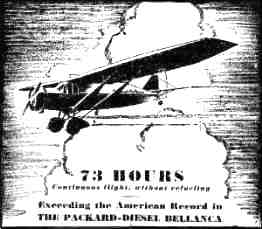

When the 225 h.p. Packard-Diesel powered Bellanca, piloted by Walter Lees and Frederic A. Brossy, descended to earth at Jacksonville, Fla., at 10:40 a. m. Wednesday morning, April 15th, it had exceeded by 14 hours and 29 minutes the American non-refueling endurance of 59 hours and 19 minutes, made in 1928 by Schlee and Brock with a 225 h. p. gasoline engine.
Aloft from 8:52 a.m. Sunday, April 12, the Packard-Diesel Bellanca remained in continuous flight for 73 hours, 48 minutes. It came within one hour and 35 minutes of equalling the world's record of 75 hours and 23 minutes set last month by the Frenchmen Bossoutrot and Rossi with a 600 h.p. gasoline engine.
Only a violent storm accompanied by a total loss of visibility which forced the Bellanca down with engine functioning perfectly and with enough reserve fuel for several hours of additional flight, prevented the
almost certain capture of the world's non-refueling endurance record. This record is recognized as one of the most important and sought-after in aviation, for not only must the powerplant function perfectly and economically during the grueling flight but at the start it must pull a tremendous load off the ground.
The Packard-Diesel Bellanca took off with a gross load of 6,666 pounds, including 458 gallons of fuel oil weighing 7 pounds per gallon. Notwithstanding this unusual weight, the plane took the air in 31 seconds. And the total cost of the fuel supply for more than three days and nights of continuous flight was but $45.80.
Thus has the supremacy of the Packard-Diesel--- both in reliability and economy---been proved again.Thus has another outstanding tribute been paid to Packard power.

